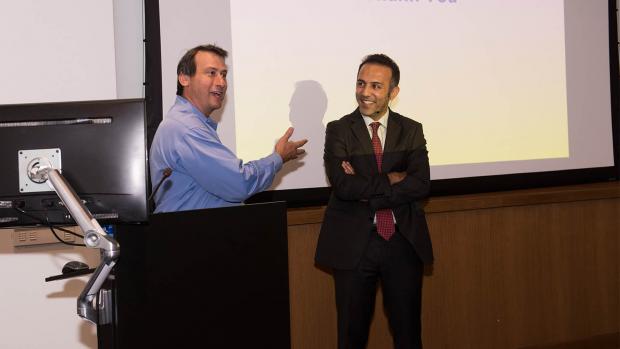Inaugural Seminar Envisions Smart Dust, Electronic Drugs, Nanochip Pacemakers, and More

Theodore Rappaport, director and founder of NYU WIRELESS, introduces Aydin Babakhani, the inaugural speaker of the new seminar series, “Circuits: Terahertz and Beyond"
A new seminar series, “Circuits: Terahertz and Beyond,” hosted by NYU WIRELESS and the Department of Electrical and Computer Engineering, kicked off with a presentation that evoked a future filled with remarkable technologies enabled by new research into the terahertz (THz) electromagnetic spectrum and new developments in low-cost silicon chips.
The inaugural seminar, featured Aydin Babakhani, an associate professor of electrical and computer engineering at the UCLA Henry Samueli School of Engineering and Applied Science.
During the presentation, entitled Silicon-based Integrated Sensors with On-chip Antennas: From THz Pulse Sources to Miniaturized Spectrometers, Babakhani described how THz technology will make possible such innovations as wirelessly-powered medical tracers and implants; THz spectroscopy that will “see” how certain fluids move through subterranean strata and where certain cancer tissues end and healthy tissue begin; airborne clouds of detectors so small they are called “smart dust;” and pacemakers comprising just a handful of wirelessly chargeable nanochips — tiny integrated circuits — which will eliminate the need for risky surgeries to replace batteries.
Detailing how miniature silicon chips have vast implications for commercial use of THz — the electromagnetic spectrum between approximately 100 GHz to 1000 GHz — Babahkani explained that the convergence of electromagnetics and high-frequency electronics are making possible integrated chips that can radiate picosecond (one trillionth of a second) pulses and synchronize wirelessly with sub-picosecond accuracy. He discussed his own work on miniaturized spectrometers and wirelessly powered sensors and actuators.
“Because new process technology makes it possible to integrate everything from antennas to processors on a single chip at almost no cost, such innovations as wirelessly powered single-chip electronic drugs for medical applications and electronic tracers for energy exploration as well as for industrial monitoring are feasible,” said Babakhani.
Babakhani also delved into future directions for wirelessly powered single-chip electronic drugs for medical applications and electronic tracers for energy exploration as well as for industrial monitoring.

“Professor Babakhani has been a leading light in wireless both as a researcher and entrepreneur since his seminal work on millimeter wave technology for on-chip antennas,” said Theodore (Ted) S. Rappaport, director and founder of NYU WIRELESS and the NYU Tandon David Lee/Ernst Weber professor of electrical engineering. “Who better to set the pace for a seminar series that will explore the future of communications, sensing and computing with eight remarkable speakers. It’s great to have these leaders as allies as we move quickly to become a leader in terahertz.”
Organized by Rappaport, Shaloo Rakheja, Davood Shahrjerdi, and Ramesh Karri — all faculty in NYU Tandon’s Electrical and Computer Engineering Department — the series continues almost weekly with seminars exploring THz communications, nanomaterials and ultra-broadband networks, phased array antennas for THz, the third wireless revolution, and more.
All seminars begin at 11 a.m. Eastern and can be watched at engineering.nyu.edu/live.




